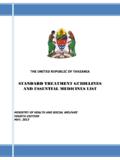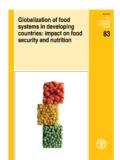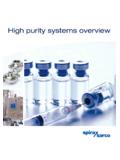Transcription of Forests and Climate Change Working Paper 15
1 Forests and Climate Change Working Paper 15. From reference levels to results reporting: REDD+ under the UNFCCC. I7163EN/1 Cover photo: FAO/Giulio Napolitano From reference levels to results reporting: REDD+ under the UNFCCC. Food and Agriculture Organization of the United Nations Rome, 2017. The designations employed and the presentation of material in this information product do not imply the expression of any opinion whatsoever on the part of the Food and Agriculture Organization of the United Nations (FAO) concerning the legal or development status of any country, territory, city or area or of its authorities, or concerning the delimitation of its frontiers or boundaries. The mention of specific companies or products of manufacturers, whether or not these have been patented, does not imply that these have been endorsed or recommended by FAO in preference to others of a similar nature that are not mentioned.
2 The views expressed in this information product are those of the author(s) and do not necessarily reflect the views or policies of FAO. ISBN 978-92-5-109783-0. FAO, 2017. FAO encourages the use, reproduction and dissemination of material in this information product. Except where otherwise indicated, material may be copied, downloaded and printed for private study, research and teaching purposes, or for use in non-commercial products or services, provided that appropriate acknowledgement of FAO as the source and copyright holder is given and that FAO's endorsement of users'. views, products or services is not implied in any way. All requests for translation and adaptation rights, and for resale and other commercial use rights should be made via or addressed to FAO information products are available on the FAO website ( ) and can be purchased through This publication has been printed using selected products and processes so as to ensure minimal environmental impact and to promote sustainable forest management.
3 Contents Foreword iv Facts on REDD+ reference levels and results reporting v Key messages vi Acknowledgements vii Acronyms viii 1. Introduction 1. 2. The evolving context for forest Reference (Emission) Levels and REDD+. results reporting 3. UNFCCC guidance and procedures 3. Modalities for forest Reference (Emission) Levels and the technical assessment 4. Modalities for REDD+ results reporting and the technical analysis 5. Recent developments in international Climate Change mitigation policy 6. 3. Technical assessment of forest Reference (Emission) Levels 9. 4. Update on forest Reference (Emission) Level Submissions 11. forest definition 11. Scale 13. Scope 13. Data selection and analysis 16. Uncertainty analysis 18. Construction approaches and adjustments 20. Reference periods 21. 5. Initial country experiences on REDD+ results reporting 25.
4 Objective of REDD+ results reporting 25. Construction approaches and REDD+ results 25. Technical analysis and areas for improvement 27. Information related to safeguards 27. Consistency with the national GHG inventory 28. Relation between forest Reference (Emission) levels and REDD+ results annexes 28. 6. Conclusions 29. 7. Annex: Reporting processes to the UNFCCC for developing countries 33. iii From reference levels to results reporting: REDD+ under the UNFCCC. Foreword For well over a decade, developing countries have been encouraged to undertake activities in their forest sectors that are designed to reduce greenhouse gas emissions while also Working to conserve, enhance and sustainably manage forest carbon stocks. These activities are known collectively as Reducing Emissions from Deforestation and forest Degradation in Developing Countries (REDD+), which was established under the United Nations Framework Convention on Climate Change (UNFCCC).
5 More recently, these actions were confirmed by the landmark Paris Agreement on Climate Change , which entered into force in 2016, as a core element of a new global Climate Change regime. Under this regime, governments have agreed on policy approaches and positive incentives for activities that reduce greenhouse gas emissions and enhance carbon sinks in the forest sector of developing countries. FAO has supported countries in their REDD+ efforts, assisting them in the development of monitoring, reporting and verification (MRV) capabilities crucial to the REDD+ process. This publication provides a status report on progress and achievements related to the MRV of REDD+. activities, as well as an update on activities related to countries' submissions of their forest Reference (Emission) Levels (FRELs/FRLs). The report also summarizes experiences with the technical assessment process, as of early 2017, and offers an overview of initial REDD+ results reporting and technical analyses of those reports.
6 It is fair to say that much progress has been made within the REDD+ framework over the past years, as countries have agreed to policy approaches and positive incentives for activities that reduce greenhouse gas emissions and enhance carbon sinks in developing countries. Within this framework, an increasing number of countries can now boast significant achievements along the REDD+ readiness path, with several moving towards implementation of these measures as part of international efforts to mitigate Climate Change . Highlights of this report include measures that show a strong uptake of FREL/FRLs among tropical forest countries. FREL/FRLs which have already been submitted involve many of the countries with the largest forest areas, and cover vast amounts of emissions from their forest sectors. There is also progress in areas that are not as easy to quantify: for example, an unprecedented level of transparency has been achieved concerning countries' forest -sector data and information, thanks to data reporting in the context of REDD+.
7 It is hugely encouraging to see the progress that has been made to date in developing REDD+. This publication highlights how one of its key components a robust MRV framework is shaping up. Hopefully, it can become a useful input for countries' further work towards participation in REDD+ and greater transparency regarding their Forests and Climate Change . Eva M ller Director, Forestry Policy and Resourses Division, Food and Agriculture Organization of the United Nations iv . Facts on REDD+ reference levels and results reporting The landmark Paris Agreement on Climate Change has created a new context for international mitigation efforts while confirming the existing framework for Reducing Emissions from Deforestation and forest Degradation in Developing Countries (REDD+). Within this framework, many countries are making progress in developing and submitting to the United Nations Framework Convention on Climate Change (UNFCCC).
8 Their forest Reference (Emission) Levels (FREL/FRLs), participating in the technical assessment of FREL/. FRL, reporting on REDD+ results through annexes to Biennial Update Reports (BUR), and undergoing the International Consultation and Analysis process. Nearly all countries pursuing REDD+ have also submitted Nationally Determined Contributions (NDCs) that include forest -sector actions. The measurement, reporting and verification (MRV) of REDD+ activities is progressing and, as of early 2017, the following milestones had been achieved: As many as 25 countries have submitted a total of 26 FREL/FRLs1 to the UNFCCC for technical assessment. The UNFCCC has published nine technical assessment reports of FREL/FRLs; a further 17 technical assessments are ongoing. Four countries have reported REDD+ results to the UNFCCC, totalling over 3 billion tCO2e in reductions, mostly from Brazil.
9 One technical analysis has been completed; the other three technical analyses are ongoing. This publication aims to inform countries of developments related to the MRV of REDD+ activities. It provides an update on FREL/FRL submissions and REDD+ results reporting, a summary of experiences to date with the technical assessment process, and an overview of initial REDD+ results reports and their technical analyses. REDD+ results 2015/2016 Brazil Colombia Ecuador Malaysia (Amazon) (TA ongoing) (TA ongoing) (TA ongoing). FREL/FRLs 2014/2015. Brazil (Amazon) Colombia Ecuador Guyana Malaysia Mexico Republic of Chile the Congo Costa Rica Ethiopia Indonesia Paraguay (TA ongoing) (TA ongoing). (TA ongoing). Peru Viet Nam Zambia (TA ongoing) (TA ongoing). 2017 Brazil (Cerrado) Cambodia Ivory Coast Ghana Honduras Madagascar (TA ongoing) (TA ongoing) (TA ongoing) (TA ongoing) (TA ongoing) (TA ongoing).
10 Nepal Papua New Sri Lanka Tanzania Uganda (TA ongoing) Guinea (TA ongoing) (TA ongoing) (TA ongoing). (TA ongoing). 1 One country (Brazil) has submitted two FREL/FRLs for separate biomes. v From reference levels to results reporting: REDD+ under the UNFCCC. Key messages The Paris Agreement on Climate Change creates a new context for mitigation as REDD+ matures from capacity development to producing results. Countries have made progress on the measurement, reporting and verification (MRV) of REDD+. activities, notably on the first two elements. In many countries, unprecedented transparency of countries' forest -sector data and information has resulted from the MRV of REDD+ as, for the first time, data at this level of detail have been reported internationally. A country's national forest monitoring system (NFMS) should provide data and information for the MRV of REDD+, the national greenhouse gas (GHG) inventory, and NDC progress reporting to enhance sustainability and consistency.














